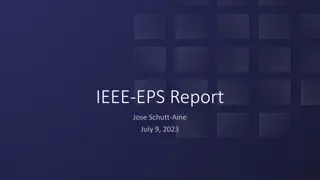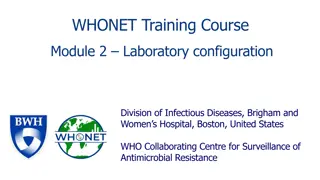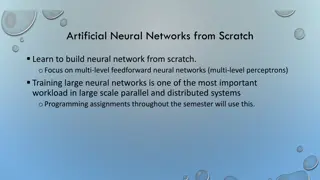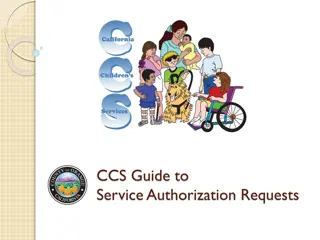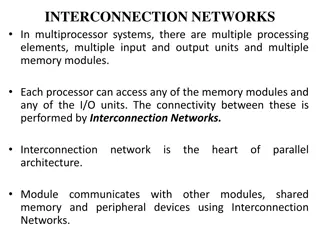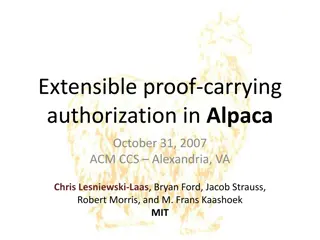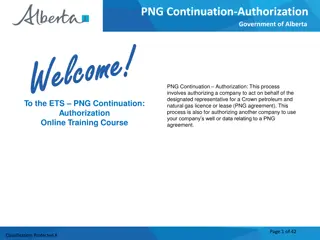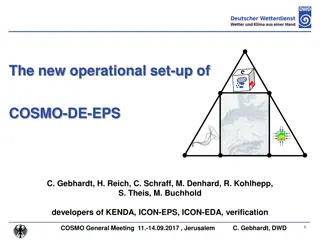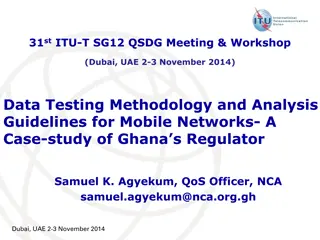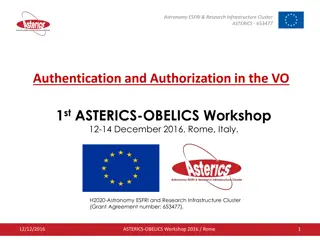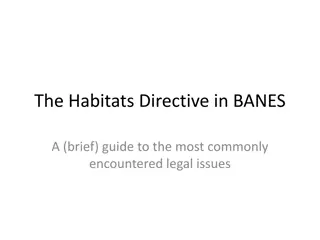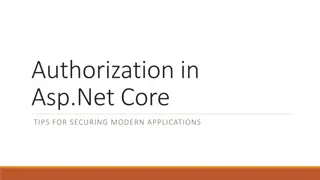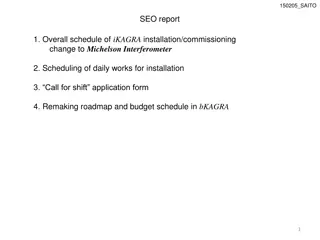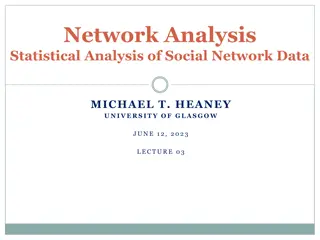Enhancing EPS Authorization and Configuration Options in 5G Networks
The proposal focuses on enhancing authorization and configuration options in EPS using protocol configuration options. It discusses the attach procedure, ePCO checking, and the importance of ePCO support in the network architecture. The solution presented emphasizes the role of MME, SGW, and PGW-C+SMF in ensuring seamless connectivity and mobility for UEs. The content sheds light on the significance of ePCO support for future releases and the implications for legacy networks.
Download Presentation

Please find below an Image/Link to download the presentation.
The content on the website is provided AS IS for your information and personal use only. It may not be sold, licensed, or shared on other websites without obtaining consent from the author.If you encounter any issues during the download, it is possible that the publisher has removed the file from their server.
You are allowed to download the files provided on this website for personal or commercial use, subject to the condition that they are used lawfully. All files are the property of their respective owners.
The content on the website is provided AS IS for your information and personal use only. It may not be sold, licensed, or shared on other websites without obtaining consent from the author.
E N D
Presentation Transcript
UUAA/C2 Authorization in EPS by using protocol configuration options Roozbeh Atarius Lenovo, Motorola Mobility ratarius@motorola.com
UE eNodeB new MME HSS Old Serving GW PDN GW PCRF MME/SGSN Figure 5.3.2.1-1: Attach procedure TS 23.401 1. Attach Request EIR 2. Attach Request Figure 5.3.2.1-1: Attach procedure simplified 3. Identification Request 3. Identification Response 4. Identity Request 4. Identity Response 5a. Authentication / Security 5b. Identity Request/Response 5b. ME Identity Check 6. Ciphered Options Request 6. Ciphered Options Response PGW-C +SMF UE eNB MME SGW 7. Delete Sesion Request 7. PCEF Initiated IP-CAN Session Termination 7. Delete Session Response (E) (A) 1- RRC request (attach request) 8. Update Location Request 2- initial UE message (attach request) 9. Cancel Location 9. Cancel Location Ack 3- create session request message 4- create session request message 10. Delete Session Request 10. Delete Session Response 10. PCEF Initiated IP-CAN Session Termination (F) (B) 5- create session response message 11. Update Location Ack 6- create session response message 12. Create Session Request 7- initial context setup request message (attach accept) 13. Create Session Request 14. PCEF Initiated IP-CAN Session Establishment/Modification 8- RRC connection reconfiguration (C) 15. Create Session Response First Downlink Data (if not handover) 8- initial context setup response message 9- direct transfer message (attach complete) 16. Create Session Response 17. Initial Context Setup Request or Downlink NAS transport with Attach Accept 18. RRC Connection Reconfiguration or RRC Direct Transfer 10- uplink NAS transport message (attach complete) 11- modify bearer request message 19. RRC Connection Reconfiguration Complete 20. Initial Context Setup Response 21. Direct Transfer 22. Attach Complete 12- modify bearer request message modify bearer response message modify bearer response message First Uplink Data 23. Modify Bearer Request 23a. Modify Bearer Request 23b. Modify Bearer Response (D) 24. Modify Bearer Response First Downlink Data 25. Notify Request 26. Notify Response
Attach procedure with ePCO checking Proposal: Attach Request (PDN CONNECTIVITY REQUEST message [PCO]) Attach Response (ACTIVATE DEFAULT EPS BEARER CONTEXT REQUEST message [ePCO support]) Attach complete (ACTIVATE DEFAULT EPS BEARER CONTEXT ACCEPT message [ePCO]) The proposal to the meeting has been that Modify Bearer Request message convey ePCO from ACTIVATE DEFAULT EPS BEARER CONTEXT ACCEPT message from MME via SGW to PGW-C+SMF. Modify Bearer Request message does not have PCO/ePCO capability according to TS 29.274.
Solution 1 ePCO Only This assumption is currently very close to what we do, except we check by sending PCO. MME support ePCO, the MME chooses: SGW due to network topology, load balancing, non-IP, ethernet capability, if supported UE assisted dedicated core network(DCN). There is no SA2 requirement for ePCO support, however if SGW supports inter system change with 5GS, it will support ePCO. I could not locate any such req. for MME/SGW and this may result in a change of MME to look for such capability but since it is not for UAS, then may be OK, however rel-17 will be first release, thus no legacy network and against SA2 requirement. Requirement for mobility and thus to find MME and SGW with this capability must also be added. If SGW does not support ePCO, the ePCO IE is dropped from passing along in create session request message. PGW due to UE s subscribed APN or e.g. UE assisted DCN locates the PWG-C+SMF which supports inter system change with 5GS and always support ePCO. MME does not support ePCO: The ePCO IE is dropped by the MME when populating create session message towards SGW and PGW-C+SMF. PGW-C+SMF may register the UE as a regular UE as a result even if it may realize the UE capability due to its subscription. The UE receives PCO support indicator back from the network, and thus should consider the network is not supporting UAS services.
Solution 1 ePCO only Pros: Messages up to 65 K can be transmitted. Cons: Only those network (MME, SGW) with inter system 5GS exchange capability which also have ePCO capability supports the UAS services. Thus rel-17 onwards and no legacy network. This is not clear how MME should locate another MME or SGW should locate another SGW without breaking no MME/SGW impact requirement. If support for intersystem 5GS change is required, then only a selected EPC can comply. If due to mobility MME and/or SGW change, the new MME and SGW must support ePCO since re-UUAA can be performed by the network. If the ePCO network support ceases, the PGW-C+SMF must release the UE. PGW-C+SMF behavior needs to be defined if a UAV UE preforms a regular registration. Even if ePCO is used, it is not clear that data is less than 65K, especially if the UE transmit data for both UUAA and C2 pairing authorization.
Follow the same procedure as for e.g. bearer resource allocation or bearer resource modification Solution 2 UUAA data transmission to trigger Modify Bearer Command form MME to PGW-C + SMF PGW-C +SMF UE eNB MME SGW Attach procedure 13- RRC request (bearer resource modification message)14- uplink NAS transport 15- bearer resource command message (bearer resource modification message) 16- bearer resource command
PGW-C +SMF UE eNB MME SGW Solution 2 UUAA result transmission Attach procedure Information for UUAA is provided Buffering information and performing the UUAA when the entire information is buffered 19- downlink NAS transport message (modify EPS bearer context request) 17- update bearer request message 18- update bearer request message 20- RRC connection reconfiguration 21- direct transfer message (modify EPS bearer context accept) 22- uplink NAS transport message (modify EPS bearer context accept) 23- update bearer response message 24- update bearer response message
Solution 2 Pros: Even PCO can be used thus the pre-release 13 MME and SGW will also work Or even newer ones which did not implement ePCO. What needs to be done is to send repetitively parts of the UUAA data on slide 4 and to receive repetitively parts o fthe UUAA results. Any size of message can be transferred since even if the messages are larger than 65K and ePCO is supported. SA2 requirement that MME does not have to be updated is fully upfilled. Cons: New procedure needs to be defined for bearer modification concept for UUAA data and C2 authorization data transmission by PCO/ePCO in TS 24.301. update bearer request concept for UUAA and C2 Authorization results transmission by PCO/ePCO in TS 29.274.


